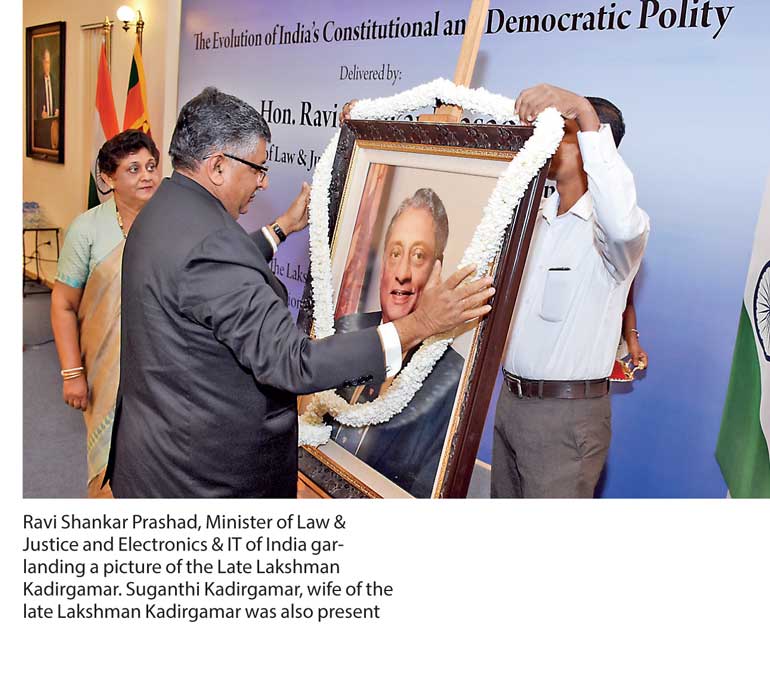Saturday Dec 14, 2024
Saturday Dec 14, 2024
Wednesday, 17 January 2018 00:00 - - {{hitsCtrl.values.hits}}



By Shannon Jayawardena
Indian Minister for Law and Justice and Electronics and IT, Ravi Shankar Prasad, in a speech delivered at the Lakshman Kadirgamar Memorial Lecture said that India had now emerged as an IT powerhouse in its own right on the global stage.
While Indian IT companies are based in approximately 200 cities in more than 80 countries, the country has emerged as a large global digital market. Facebook and WhatsApp have the largest user base in India and the country has the largest number of downloads of android mobile apps while the use of Twitter, Instagram and Amazon is also rapidly growing.
Minister Prasad stated: “We opened 300 million bank accounts for those who did not have bank accounts, linked it with Aadhaar, seeded them mobile phones and started delivering their welfare entitlements directly into the bank accounts. In the process we have saved around $ 9 billion. Technology thereby is being employed to increase access to healthcare and education in a substantial manner.”
India’s digital literacy program called PMGDISHA is aimed at imparting basic digital training to over 60 million adults who have no access to the IT sector or knowledge on IT or the usage of its tools. More than 270,000 Common Services Centres are providing over 300 digital services to people living in the villages of India and have created employment for around one million youth.
“Our incentives to develop IT and BPO centres in small towns of India have created jobs for the people in small towns without the need for migrating to big cities. Simplification of taxation and implementation of nationwide single direct tax called the Goods and Service Tax in which technology is playing a significant role has developed India into a unified single market,” said the Minister.
“Our digital policies have prepared the ground for the launch of our digital economy to its true potential of a trillion dollars over the next few years. The combined results of all these initiatives have been that of India’s growth story. Substantially driven by technology, it is finding its resonance on the global stage.”
According to the World Bank, the Indian economy will grow at 7.3% and become the fastest-growing economy in 2018, while at present the country has moved up 42 places in the Ease of Doing Business Index of the World Bank from 142nd place in 2014 to 100th place in 2017.
India has also witnessed the highest-ever Foreign Direct Investment during 2016-2017 at $ 60 billion. The Foreign Direct Investment (FDI) Confidence Index 2017 ranked India at eighth position among 25 countries.
NEW DELHI (Reuters): India will build facial recognition into its national identity card in addition to fingerprints after a series of breaches in the world’s biggest biometric identification program, the government said on Monday.
A local newspaper reported this month that access to the “Aadhaar” database which has identity details of more than 1 billion citizens was being sold for just $8 on social media.
The Unique Identification Authority of India (UIDAI), which issues the identity cards, said it would add face recognition software as an additional layer of security from July.
Card holders will be required to match their photographs with that stored in the data base for authentication in addition to fingerprints and iris scans, the agency said in a statement. Many card users have complained in the past that fingerprint authentication has not worked because of changes in the case of the elderly and labourers since the time the original prints were taken.